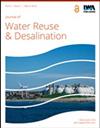城市污水反渗透中试系统中氯消毒引起的加重生物污染
IF 2.3
Q2 Environmental Science
引用次数: 25
摘要
反渗透(RO)系统广泛应用于生产高标准工业用中水。氯消毒是反渗透污水回收系统中主要的生物污染控制方法。然而,研究人员报告了氯消毒的不良影响,它加剧了实验室规模的反渗透系统中的生物污染。本研究采用4个平行的4英寸螺旋缠绕反渗透膜,在中试规模反渗透系统中研究氯对生物污染的影响。4个实验组游离氯剂量分别为0、1、2、5 mg/L。给水经过连续加氯和脱氯后,进入反渗透系统。结果表明,氯处理导致反渗透系统给水相对压力升高1.9 ~ 36.7%,表明氯加重了中试反渗透系统的膜污染。采用PMA(单叠氮丙啶)-PCR法检测反渗透系统给水中活菌的微生物群落结构,结果显示消毒后耐氯菌(CRB)的相对丰度显著增加。在高氯剂量的实验组中保持较高相对丰度的9个主要属被认为可能是引起膜污染的关键菌种,包括Pedobacter、Clostridium和Bradyrhizobium。本文章由计算机程序翻译,如有差异,请以英文原文为准。
Aggravated biofouling caused by chlorine disinfection in a pilot-scale reverse osmosis treatment system of municipal wastewater
The reverse osmosis (RO) system is widely applied to produce reclaimed water for high-standard industrial use. Chlorine disinfection is the main biofouling control method in the RO systems for wastewater reclamation. However, researchers reported the adverse effects of chlorine disinfection which aggravated biofouling in laboratory-scale RO systems. In this study, four parallel 4-inch spiral wound RO membranes were used to study the effect of chlorine on biofouling in a pilot-scale RO system. The free chlorine dosages in four experimental groups were 0, 1, 2 and 5 mg/L, respectively. After continuous chlorination and dechlorination, the feed water entered the RO system. It was found that chlorine pretreatment caused a 1.9–36.7% increase in relative feed water pressure of the RO system, suggesting that chlorine aggravated the membrane fouling in the pilot-scale RO system. The microbial community structures of living bacteria in the feed water of the RO system were determined by the PMA (propidium monoazide)-PCR method and showed that the relative abundance of chlorine-resistant bacteria (CRB) was significantly increased after disinfection. Nine major genera which maintained higher relative abundance in experimental groups with high chlorine dosage were considered as possible key species causing membrane fouling, including Pedobacter, Clostridium and Bradyrhizobium.
求助全文
通过发布文献求助,成功后即可免费获取论文全文。
去求助
来源期刊

Journal of Water Reuse and Desalination
ENGINEERING, ENVIRONMENTAL-WATER RESOURCES
CiteScore
4.30
自引率
0.00%
发文量
23
审稿时长
16 weeks
期刊介绍:
Journal of Water Reuse and Desalination publishes refereed review articles, theoretical and experimental research papers, new findings and issues of unplanned and planned reuse. The journal welcomes contributions from developing and developed countries.
 求助内容:
求助内容: 应助结果提醒方式:
应助结果提醒方式:


